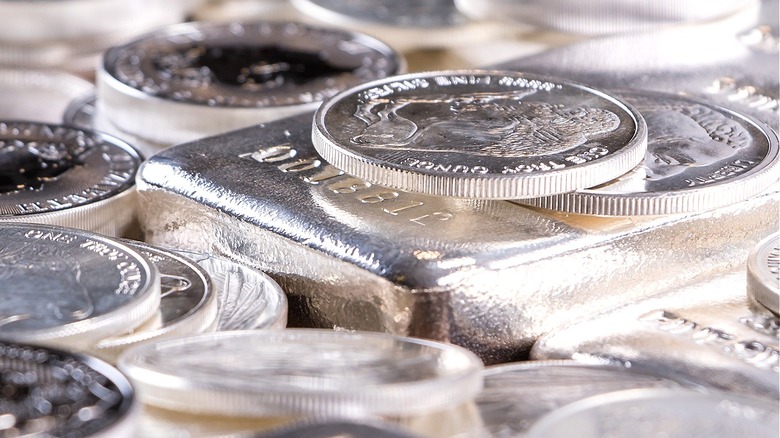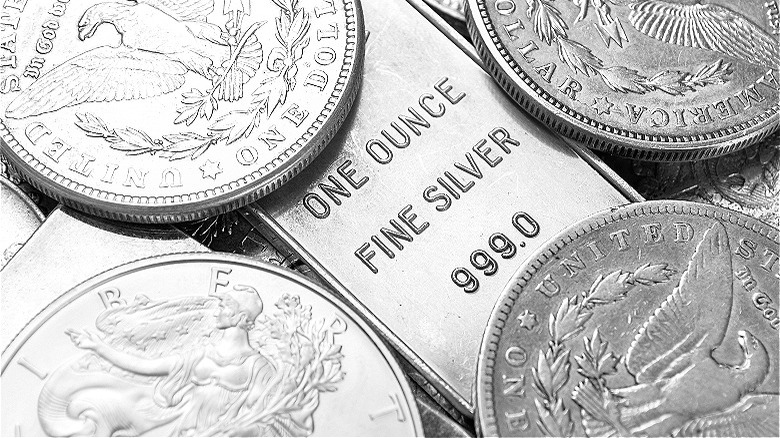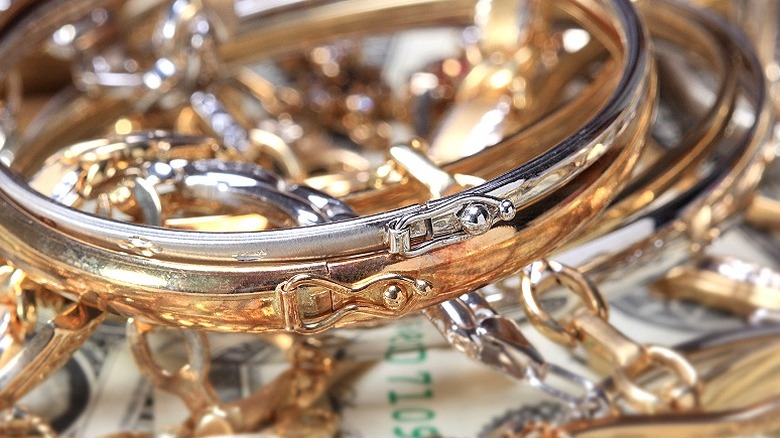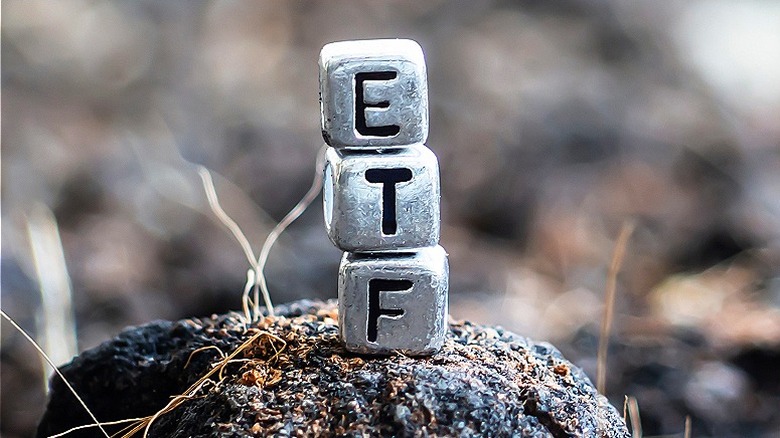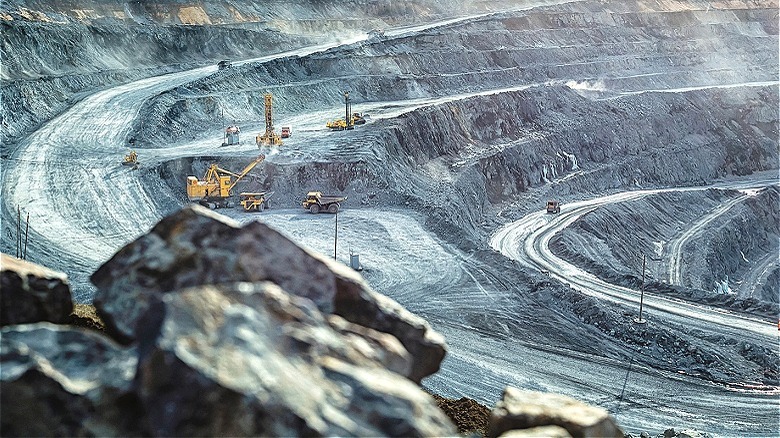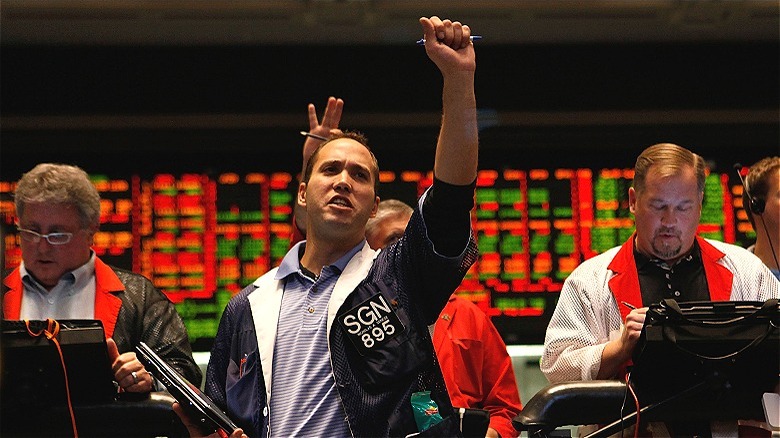The Ultimate Guide To Investing In Silver
Buying precious metals, like silver, as a component of a broader investing strategy has long been considered an effective way to diversify portfolios and provide stability against fluctuations in the stock and bond markets. In particular, precious metals are viewed by many experts as an effective method to hedge against inflation, which has manifested itself following shutdowns, supply chain issues, and monetary stimulus driven by the COVID-19 pandemic. That's because, historically, precious metal prices have risen when the dollar loses value.
Traditionally, investing in gold has been a popular choice for dabbling in precious metals, but silver is also a solid choice, and much more affordable than gold. At the time of writing in early April 2024, gold is presently trading at approximately $2,250 per troy ounce while silver is fetching about $25 per troy ounce. Now would be a good time to mention that precious metals prices are always quoted in troy ounces, a unit of measurement that originated in France during the Middle Ages. A troy ounce is equal to 31.10 grams.
Besides being an investment vehicle, silver is also used in industrial applications, such as manufacturing electronics. In fact, more than half of the world's silver supply over the last five years has been allocated to industrial uses. Therefore, economic growth can also buoy silver prices beyond that of a simple store of value.
Physical silver coins or bars
In a world that's growing increasingly electronic, owning physical silver can be a satisfying throwback to simpler times. Bars, coins, or other forms — collectively referred to as bullion — of physical silver are available for purchase. This investment-grade silver, which must be at least 99.9% pure, can be stored in your home safe or bank safety deposit box. In urban areas, investors may be able to purchase silver in various forms from specialty dealers or even pawn shops. Failing that, popular online vendors like APMEX and JM Bullion are there to serve your needs.
Regardless of where you elect to purchase physical silver, do be aware of the current spot price, which is the current market value prior to conversion into coins, bars, or other vessels. Granted, the price of silver bars and coins will always carry a slight premium to the spot price of the underlying metal because of the labor and machinery costs involved with creating bullion products.
That said, for purely investment purposes, you'll want to avoid intricately designed or specialty collector coins and the like. As attractive as those items might be to look at, the premium over the base metal can be significant. Stick with simple designs and purchase in larger quantities for the best economy. For example, 10-ounce or 100-ounce bars will represent a better value than 1-ounce bars.
Considerations to owning physical silver
Since purchasing physical silver in the form of bullion is one of the most popular methods to invest in the precious metal, Money Digest also wants to spend some time discussing a few special considerations associated with this method. First, buying physical silver could include paying sales tax during the purchase process, though policies vary by state. A good resource for researching state sales tax laws with regard to precious metals can be located on the APMEX website. Also note that sales tax rules are typically applied per the state where the order is shipped, which might not be the same as your home state.
Next, physical silver may not be as liquid as investments that are traded electronically. That is, you'll need to take or ship your silver bullion to a buyer or dealer, and that party will want to make a profit from the transaction. Of course, electronic transactions like stock trades have a small difference between the buying and selling price, too, called the bid-ask spread. However, this price discrepancy may be larger when transacting in physical commodities.
Finally, consider that you'll need a safe location to store your silver bullion against theft. Unlike some items that should never be stored in a safe deposit box, silver bullion is a good candidate for this type of safekeeping. Silver owners might also wish to insure their investment, either separately or by adding additional coverage to an existing home or renters insurance policy.
Consider a silver ETF for convenience
If buying, storing, and possibly insuring physical silver in the form of bars or coins seems like too much of a hassle, consider investing in an exchange traded fund (ETF) that owns silver. Simply put, an ETF that owns silver will track the price of the precious metal, minus the fund's expense ratio.
An expense ratio is defined as a sort of management fee to the owners of the funds in exchange for running it. For example, a fund charging 0.5% will charge $50 annually for every $10,000 invested. Though don't expect to explicitly be billed for those charges, because they're most often collected at regular intervals behind the scenes.
Still, that's potentially more economical than potentially paying sales tax when buying physical bullion, not to mention that the spread between asking and selling price is likely narrower than with physical bars or coins. As well, silver ETFs can be bought and sold through any standard online brokerage or app at the tap of a screen or mouse click.
Shares of silver mining stocks
Another alternative to owning actual silver bars or coins is to purchase shares of stock in publicly traded companies that extract silver from the earth. Note that most silver miners are also diversified into mining other metals like aluminum, copper, and even gold. As such, investing in publicly traded mining companies isn't strictly a silver play, but metals, in general. Therefore, investing in miners could be an unintended (or perhaps intended) diversification move.
However, investors will note that shares of mining company stocks won't correlate exactly with the price of the underlying metals they're extracting from the earth. For instance, the success of mining operations, especially newer ones, will vary among firms. Similarly, different efficiencies and expenses in capital and equipment exist between firms, like any other business sector. As well, the value of mining stocks may diminish in a recession, when the manufacturing of goods typically slumps. In general, the newer companies — sometimes called "juniors" — may have the potential for a higher return on investment, but they're also more risky. More conservative investors will probably gravitate toward major, well-known names instead.
Buying silver futures is an advanced technique
In the iconic comedy "Trading Places," the film's two central characters make a fortune trading orange juice futures on a New York City commodities trading floor. Do you know what else trades in the commodities (aka futures) market? That's right, it's silver. Futures contracts are an agreement to receive an actual quantity of a commodity at a future date at an agreed-upon price, but in reality, most traders don't opt to receive the physical commodity. Instead, they'll either sell the futures contract prior to its expiration date or if held to expiration, option writers award any profit in cash rather than the actual commodity — silver in this case — unless special arrangements are made.
Trading futures contracts is an advanced investing technique to be sure, and isn't for the faint of heart. One of the characteristics of futures is the tremendous leverage involved. That is, a relatively small amount of money controls a large quantity of silver. As such, profits are amplified, but so are losses. Also, futures have a fixed period of time before they expire, which can vary from a few weeks to more than one year. If the price move you're expecting doesn't occur within that time frame, the position can expire worthless.
